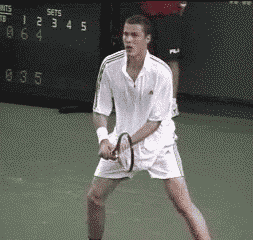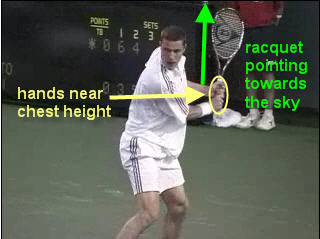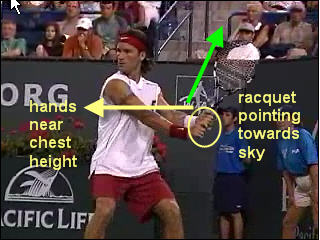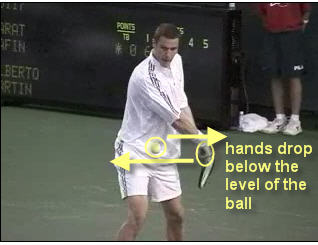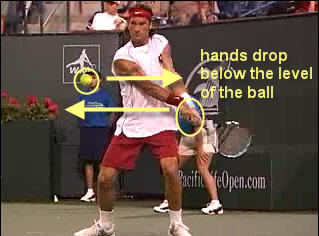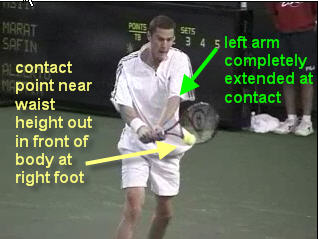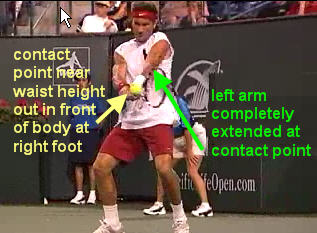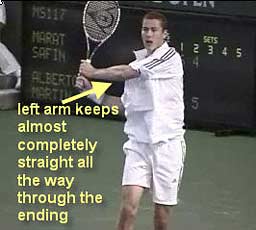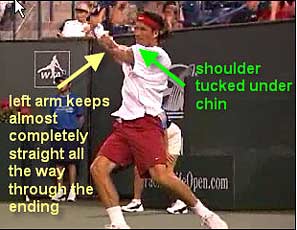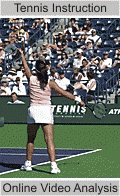|
TennisOne Lessons
The Extension Backhand by Heath Waters So, who has the most feared backhands on the men's professional tour? If you talk to most of the male pros, two names in particular come up frequently, Marat Safin and Carlos Moya. Safin and Moya not only have two of the biggest backhands on tour but two of the biggest backhands in history. Both players utilize very similar, extremely efficient, and simple to learn techniques on the backhand.
Using The ACE System, we will break down the fundamental commonalities of these great backhands into three easy to understand steps and then show you how you can apply these same fundamentals to your own game.
The ACE System consists of breaking a stroke down into three phases; the preparation, the hitting zone, and the ending. We then derive similar fundamental reference points from these phases for you to learn from and apply to your own game. So let's get to it. Step One: The Preparation The first step we will look at is the preparation phase of the stroke. Note that both players take the racquet back by coiling the hips and the upper torso. This assures the racquet is taken back consistently to the same spot each and every time and will allow for more storage of kinetic energy to be unleashed upon the ball. The two fundamental commonality reference points to mimic in the final preparation position of the backhands of Safin and Moya are the hand position and the final position of the racquet before the downswing. The first reference point to note is the position of the hands. Both players place the hands near chest height as illustrated in the above pictures. Placing the hands at this height allows the players to generate more racquet head speed before making contact with the ball. The second reference point to note is the position of the racquet. Both players hold the racquet with the head pointing upward toward the sky in the final preparation position before they start their downswing. By taking the racquet up high like this, the player's are able to use gravity to their advantage.
From this high position the racquet will gain more momentum before contact without having to use as much of their own energy to strike the ball as opposed to a straight back classical style two-handed backhand used predominantly a couple of decades ago. I encourage all amateur two-handers to try this preparation. By making this simple minor adjustment to your current backhand preparation, it will immediately and naturally provide you with additional power. Step Two: The Hitting Zone In step two there are two specific reference points you should mimic that both Safin and Moya employ during the hitting zone phase of the backhand. The first reference point to note is the dropping of the hands below the level of the ball just before contact. This action is vital to creating topspin and it also helps induce rhythm during the stroke. The second reference is the left arm position at contact point. Note that the left arm is completely extended and the contact point is out in front of the body at the right foot and always between waist and chest height. In The ACE System we call this form the extension form because of these particular reference points. This form is the purest and simplest form of all backhands.
Whether you are a novice or an advanced beginner, practice making contact at waist height on each and every ball and make sure that at contact your left arm is straight and contact is made out in front of your body at the right foot. Start by dropping a ball on the ground and just practice getting the feeling of what it's like to hit the backhand at the right foot in front of your body with the left arm straight at contact. Once you get this down you will quickly find your backhand landing deeper in the court and more consistently than ever before. Try it, I guarantee you will be amazed. All the great backhands possess these two fundamental commonalities; so if you forget any part of this article please don't forget to achieve waist height contact and get the left arm straight by the time you make contact. Step Three: The Ending In step three we will only give you one reference point to keep things simple. The reference point to mimic is of course, the follow through. Specifically, note how the left arm ends, extended out in front of the body rather than bent at the elbow and wrapped completely around the neck, as you will typically see so many players do. This is the purest and simplest ending form of all backhand techniques. The reason being, the simpler something is, the less that can go wrong with it. So, these guys, for the most part, simply use a loop backswing and swing straight through the ball with great extension toward their intended target. With this ending the strings follow the target longer than any other form and consequently the ball stays on the strings longer. This gives a player more directional control of the ball as well as greater depth on the shot.
I teach this ending quite frequently and I have had great success with both professional players as well as juniors. It is easy to learn and if it is dominating the pro tour it can dominate all levels of play. So there you have it. I have broken down the backhand technique of two of the most feared ball strikers in the game today and put it neatly into an easy to understand step-by-step system for you to follow. Now it is your turn to go practice these three steps and master the reference points one by one. Once you have done that, you will have added one more weapon to your arsenal of shots. Keep me posted about how it goes. Your comments are welcome. Let us know what you think about Heath Waters' article by emailing us here at TennisOne .
This invaluable visual comparison, combined with the detailed analysis by a current tour professional coach, offers the most advanced and unique learning environment in tennis. Pro Tech will store your video lessons for two years on your own web page, so you and your coach can evaluate your progress from anywhere in the world. TennisOne members receive a 10% discount. |
||||||||||||

